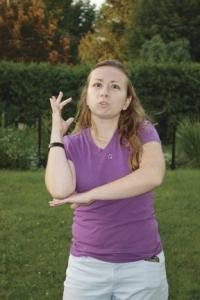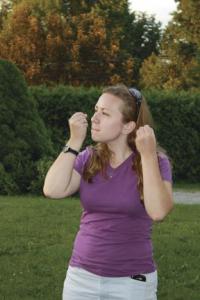
Serving the Vermont Champlain Valley Area for 45 Years
Main SectionsFront Page SportsValley VitalsIt's in the StarsStarwiseArchivesLinksAbout The VoiceContact Us |
In Praise of Sign Language: Sharing a Window Into the World of Deaf Education with Stephanie Boat
Tuesday August 3, 2010 By Cookie Steponaitis It took only a fraction of a moment. Stephanie Boat’s hands moved quickly and her face was alive with expression and meaning. Pausing, the 20 year old college junior grinned and asked, “Did you get that?” In translation, the sign language had read, “Train gone, sorry, or the American sign language meaning, “Too bad, you missed it, and I’m not repeating it.” Three simple signs, and raised eyebrows to delineate the topic of the sentence, and a facial expression to convey the too bad meaning. American Sign Language is the visual expression of a language that most Americans barely know of and fewer still learn. Stephanie Boat uses sign language as interchangeably as most bilingual Americans switch spoken languages. A junior at Rochester Institute of Technology, National Technology of the Deaf, and pursuing a BS In American Sign Language & Interpreting, Stephanie lives in dorm with deaf students and interprets as part of her college studies. “ I want to be a nationally certified sign language interpreter,” Stephanie shared, and after I have graduated, I would like to free lance work or work for the government.” Drawn to sign language as a child for the first time when she was five and visiting her grandmother in Dallas, Texas, Stephanie was fascinated with the movement of the hands of a person who was signing the church service at the First Baptist Church of Dallas. Staring intently at the individual, she was fascinated with the ease, grace and expression of the signs. Not knowing she was actually witnessing the expression of a language, she was nonetheless drawn to the practice. It wasn’t until her family moved to Vermont in 1996 and she began to see the use of sign language in the Victory Baptist Church Deaf Ministry that her fascination took on a life of its own and became a career and a passion. “ They had classes at first, kind of a crash course,” she recalled. “ We would practice vocabulary, the basics and how to communicate at a basic level using sign. I was ten at this time and I kept my interest up by signing songs on the radio, jingles on the commercials and kept studying the basics so that when I could study more I was ready.” Formal training began for Stephanie at Skyline High School in Dallas, Texas where she was fortunate to run into high school teacher Leonard Rufus who taught sign language. “The fact that he knew so much and was willing to share it, opened doorways for me,” reflected Stephanie. “He would explain it and was patient and fostering. Never did I feel what I did know was discredited by what I didn’t know. He taught me so much. ”Like the spoken language of English, sign language also has some signs that are regional. “ Depending on where you are depends on which ones you use,” explained Stephanie. “There must be thirty signs for birthday. If you aren’t understood, you try to give an example or explain using a story, and as last resort you can finger spell it to the person.” As mind boggling as it sounds now, the concept that education required a person to hear actually took shape in the mind of the great ancient Greek philosopher Aristotle, who equated the ability to hear the spoken word with the ability to be educated. This misconception ushered in a period of almost 2,000 years of misbelieve and suffering for deaf people world wide. It wasn’t actually until the Renaissance in Europe that Geronimo Cardano, who was an Italian physician, recognized that hearing was not required for education, and began teaching his own son using the written word. At the same time, a Benedictine monk, Pedro Ponce de Leon was educating deaf children of wealthy Spanish families and gained recognition for the depth of their education. Juan Pablo de Bonet, also a Spanish monk was encouraged by Leon’s successes. He incorporated reading, writing and teaching methods with the first known manual alphabet with hand symbols representing sounds and created the first known form of sign language. Tragically it wasn’t until the 1750’s that the first organized educational program for deaf education was created in Paris. A French priest, Abbe Charles Michel de L'Epee, established the first public school for the deaf in 1771 and combined the signs the children had been using in their homes with French. The life work of this man is credited as the beginning of what is known as Old French Sign Langauge and has earned L’Epee the title of the Father of Sign. At the same time in Germany, an educator named Samuel Heinicke promoted an oral method of deaf education that earned him fame and recognition. While he did use a manual alphabet, he believed that a spoken language did form the foundations for a complete education. Since the 1700’s the viewpoints of how to best educate a deaf person have grown to include differing views. One view, Oralism is the belief that you will learn English as a spoken language and use no sign language. Another philosophy in deaf education today is the Bilingual/Bicultural philosophy in which each sign is used to teach any subject matter. In addition, the deaf individual embraces American Sign Language as a means to learn English and realizes both a hearing American and Deaf Culture. The most prevelant philosophy in deaf education is a mixture of oralism and English based signing systems. Then lastly, is the philosophy of maintaining signing as the only means of communication in a traditionally speaking world. Stephanie encouraged Voice readers to include knowledge ob both William Stokoe , Thomas Gallaudet and Laurent Clerc in their understanding of the evolution of American sign language. “William Stokoe was a linguist in the 1960’s,” shared Stephanie. “He decided to delve deeper into sign language. He found out that between grammatical markers created by using your face; for example, raising your eyes brows and leaning forward, you are asking someone a question, and the fact that you put a sentence together is totally different from English, actually closer to Spanish structure. He found out it has its own components of a spoken language except for it was signed and demonstrates that American Sign Language is its own language.” Added to his work was the contribution of Thomas Galladuet who is credited with bringing sign language to America. He was a minister and his neighbor was a wealthy man with a deaf child. The man wanted his daughter to communicate and learn about the world around her. Galladuet said, “Let me look into it and see what we can do to help her.” It took him to England to study and France. He looked at Epee’s school and collaborated on the French sign language which was sophisticated. Laurent Clerc, a teacher at the Epee school came back to America with Galladuet and the pair created what is known as the first form of American Sign Language, merging French sign language with American features. In a nation that has three million deaf people, roughly 1% of the population, Stephanie feels that there are many misconceptions and lingering stereotypes in society that limit both deaf and speaking individuals. “I think that the fact that the Deaf community and sign language is a virtually an unknown part of American culture drew me to it at first. What has kept me involved in it, is that it is always changing and evolving. People do not see it as a culture and a language together .They think it is mime pictures and that all is based on the English language. Not many realize it has its own grammar rules, idioms and really represents a language of its own,” shared Stephanie. “However, I think the biggest misconception that is that the government and many Americans view deaf people as disabled. No, they can’t hear, but they can read, drive cars, attain college degrees and lead both companies and nations. The general public look upon them as people to be pitied and distances themselves from them. Deaf people can do anything accept hearing. They have a distinct learning style that is unique, but that doesn’t mean that they can’t have college degrees and accomplish any feat that someone who can hear does. Do not look them as disabled.” While most of the Deaf population in America is congregated on the east coast, and particularly in the Washington, D.C. area, there are Deaf Americans in all fifty states. Many businesses, both public and private have employees with sign language training to make daily transactions like going to the bank, post office or the grocery store more accessible and less frustrating to the Deaf population. With her hands and her gestures, Stephanie opens a window into another world in America where few of us have ventured. She continues her studies and her mission to bring awareness about a language and a way of life that three million Americans live daily. As former deaf educator Thomas Gallaudet remarked, “The only thing that deaf people can’t do is hear and they certainly can learn.”
|
AdvertisementsSearch our Archives |
Agricultural Weather Forecast:

© 2006-18 The Valley Voice • 656 Exchange St., Middlebury, VT 05753 • 802-388-6366 • 802-388-6368 (fax)
Valleywides: [email protected] • Classifieds: [email protected] • Info: [email protected]


 Printer Friendly
Printer Friendly